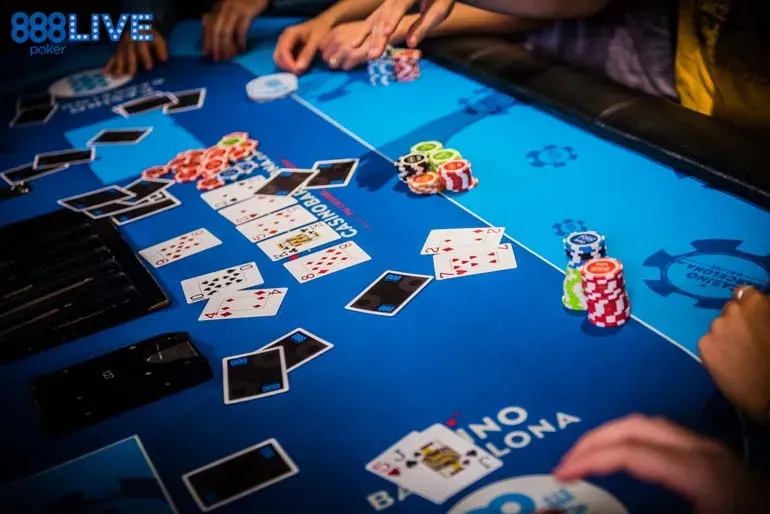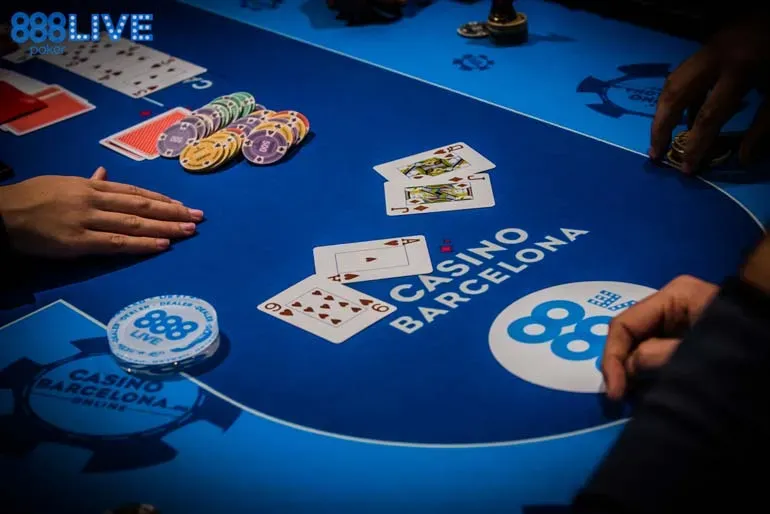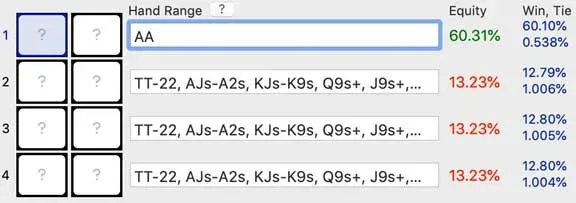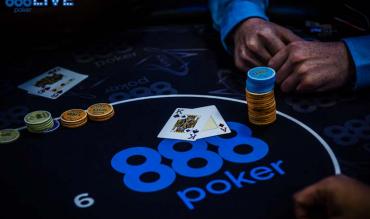The beautiful thing about poker is that anyone can win! Sure – there are specific strategies and tactics you can use to increase your chances of winning.
But luck still will undoubtedly play a significant factor in determining your short-term results at the end of the day.
To help you better understand your chances of winning any hand, we’re going to expand significantly on the topic of poker preflop odds in this article:
- Any Hand Can Win!
- Preflop Probabilities in Poker
- Preflop Equities in Texas Hold’em Poker: Hand vs Hand
- Preflop Equities in Texas Hold’em Poker: Hand vs Range
- Getting Better at Knowing Your Preflop Equities
- Preflop Poker Odds: General Strategies for Preflop Play
- Preflop Poker Equities: Having the Right Odds
- How the Number of Players in a Hand Affects Your Preflop Poker Odds
- How Bet Sizing Affects Your Preflop Poker Odds and Hand Ranges
Any Hand Can Win!
Firstly, it’s essential to realise that, before the flop in Texas Hold’em poker, no hand has completely dead equity.
In other words, say your opponent has Pocket Aces. Any two cards you’re dealt still has a chance of improving enough to crack those bullets!
Does this mean that you should play every hand before the flop? No, absolutely not! Many players frequently expand their preflop starting hand range to include too many hands. This “preflop looseness” is often the most pertinent single determining factor in why these players lose most of their money at the table:
Loose players will often get involved in the following situations –
- Where they’re dominated
- Or have kicker problems
- Or have the lower end of a flush or straight when their opponent holds a better one
So, (yes!) any hand CAN win preflop.
But don’t always try to beat the odds and test your luck this way. You’ll find yourself in a world of hurt all too frequently if you do.
 Preflop Poker Odds: Any Hand Can Win!
Preflop Poker Odds: Any Hand Can Win!
Preflop Probabilities in Poker
Texas Hold’em starts with players receiving two cards each. To understand the odds of being dealt a particular hand, we’d begin by multiplying 52 unknown cards (1st card dealt) by 51 unknown cards (2nd card dealt).
Then we’d take the product of 2,652 and divide it by 2 to see that there are 1,326 different hole card combinations in poker.
NOTE: This last step of dividing by 2 is because the order of the two cards is irrelevant: 8♥7♥ is still the same hand as 7♥8♥.
Next up, say you wanted to find out the per cent chance of a specific hand. You must determine the number of combinations there are of that hand. Then divide the result by 1,326.
Let’s take a brief look into the poker combinatorics of receiving specific hands in poker:
- A paired hand will have SIX total combinations
- A non-paired hand will have SIXTEEN total combinations
- Off-suit non-paired hands will have TWELVE combinations
- Suited non-paired hands will have FOUR combinations
For example, there are six combinations of Pocket Aces. We would take 6 divided by 1,326 (total hand combinations possible) to determine getting Aces every 1 in 221 hands, or about 0.5% of the time.
Preflop Equities in Hold’em: Hand vs Hand
Check out the preflop poker equity chart located here. This chart is the ultimate guide for following, memorising, and understanding the following –
- How preflop equities of different hands will change depending upon what hand we’re facing.
For example, if an opponent has AA, did you know it’s better to face them with 72o (11% equity) than AK! (8%)?
So, it’s crucial to get a general sense of preflop equities. This factor is especially applicable to tournament players who will go all-in preflop more frequently than cash game players.
And it will help you develop an intuition on how to act with specific hands.
| NOTE: If you ever want to get more specific in your calculations, check out our Free Online Poker Calculator. You can use it to determine the exact equities of two or more hands pitted against each other. You can even add in the community cards to see how different flops/turns/rivers will affect a hand’s equity and chances of winning at showdown. |
There is a flaw in relying too much on this chart, though. It accounts for the fact that you know your opponent’s two cards.
This situation will never be the case in poker, which brings us to the next section…
Preflop Equities in Texas Hold’em: Hand vs Range
We need to account for the “unknown” factor of your opponent(s) ’s hole cards. So, it’s essential to group their possible holdings into what’s called a hand range.
Only then will you be better able to calculate more accurately what your hand’s equity truly is.
| NOTE: To account for hands in a range, you can use PokerCruncher (Mac/ iOS) or Equilab (Windows). Particular HUD software (like PokerTracker4 available for Mac and PC) will also include poker equity calculators that can account for hand ranges. |
For example, suppose you’re in the big blind with 8♥7♥.
What’s your equity against a player who opened Under-the-Gun (first to act) in a 6max game?
Here’s the range we’ll input for the UTG player (~15% of starting hands):

Next up, we input our hand of 87s into the equity calculator.

Here, we can see 87s would have about 37% equity against the UTG range.
Getting Better at Knowing Your Preflop Equities
For the hand-vs-hand situations, you will need to memorise the chart. You may perhaps need to practice with an equity drilling calculator (like Uhlvar Equity).
For the hand-vs-range situations, it’s a little bit trickier due to the vast number of different scenarios you could encounter. Ultimately, though, the more you see how a hand fairs against a particular range, the more you’ll have a natural knack for knowing how you’re fairing.
But to get better at preflop equities, you must put in the practice.
| TIP: Do you find yourself struggling with calculating odds and probabilities in poker? Check out this helpful article to help you out: 7 Tricks to Make Easy Poker Odd Calculations. |
Preflop Poker Odds: General Preflop Play Strategies
Regarding preflop play in poker, it can sometimes be challenging to know precisely what action to take. Sure, if action folds to you, you can easily use RFI charts to know what hands to open-raise.
But what about when there’s already a raise and/or 3bet in front of you?
There are usually several different factors you need to consider, such as the following:
- Your Table Position (and the Number of Players Left After You)
- Your Opponent(s)’s Table Position
- The Raise Size Used
- Your Stack Size
- Stack Size of Other Player(s) in the Hand
- Strength of Players Left to Act After You
- Number of Players Left to Act After You
- Your Actual Hand
- Your Opponent(s)’s Hand Range
- Whether You’ll be In-Position/Out-of-Position for Post-Flop Play
Here are some general strategies you can use if there’s already action before you:
- After someone else has limped (just called the big blind), limping yourself and raising are both acceptable options. Your play will depend on your table position and how you want to construct your ranges. Also, consider if you wish to see a flop and play the hand.
- If another player has raised, you should generally use a 3bet-or-fold strategy (especially in the Small Blind vs a late-position open)
- If you’re in the big blind, it can be acceptable to call with a much wider range than otherwise. You’ll close the action and also get a better price than anyone else, with 1bb already in the pot.
- It can be acceptable to call in-position vs an open-raise with about 2-5% of hands, depending on your table position and that of the original raiser.
- If you’re in the big blind, it can be acceptable to call with a much wider range than otherwise. You’ll close the action and also get a better price than anyone else, with 1bb already in the pot.
- If you elect to call a raise, it’s generally advantageous to be (1) in position and (2) call with a hand that dominates some of your opponents opening hand range. This hand might be too weak to 3bet, for example –
- Say you’re 3betting AQo on the button vs an UTG open. You keep in hands like ATo and AJo, A2s-A9s, that you currently beat but might fold if you 3bet.
 Preflop Poker Odds: General Preflop Play Strategies
Preflop Poker Odds: General Preflop Play Strategies
- 3bet for value with your strongest hands vs another player’s open raise.
- 3bet as a bluff with hands just outside the spectrum of what you could call another players open-raise.
- Avoid “cold calling” if there’s a 3bet in front of you; either 4bet or fold.
- You can usually play a little bit looser than average if one or more of these factors are satisfied:
- The open raise is smaller than usual.
- The effective stack size is deeper, and you have position.
- There are weaker players involved in the pot.
Preflop Poker Equities: Having the Right Odds
When you’re in the big blind, you’ll need to call a raise with a significantly greater number of hands. This frequency will be larger than you would if you were (let’s say) on the button and facing a raise.
The reason for this is that you already have 1bb invested in the pot. So, you have better odds to call and see a flop.
That said, two additional factors you should consider are the following:
- You’ll be out of position each postflop betting round.
- How strong your opponents are with their post-flop play?
If you’re in the big blind, a player on the button raises to 2.5x, and the small blind folds. You would need to call 1.5bb to win 4bb currently in the pot:
- 2.5bb open raise + 0.5bb small blind + 1 big blind you already put in the pot
So, you’d need to have 1.5/(4 + 1.5) = 27% equity against the button’s range of hands to call.
But you’re out of position. So, you might need anywhere from 5% to 7% additional equity to account for this. (So, hands that have 32% or more equity against the button RFI range.)
If you’re starting out, note that it’s better to overfold from the big blind than to play too many hands from this position.
Beginning players will make too many post-flop mistakes, which will, in turn, make their winrate suffer dramatically.
How the # of Players Affects Preflop Poker Odds
As outlined in the last section of this poker probability article, the more players there are in a hand, the more your equity will diminish. This scenario will also lower your chances of having the best hand at showdown.
For example, let’s put Pocket Aces against the following hand range:
TT-22, AJs-A2s, KJs-K9s, Q9s+, J9s+, T8s+, 97s+, 86s+, 76s, 65s, 54s, AQo-ATo, KTo+, QTo+, JTo

Against one player, AA has 83% equity:

Against two players, AA has 71% equity:

Against three players, AA has 60% equity:

So, the more players there are in the hand, the lower your equity will be. (This is why it’s usually good to try to raise and get heads-up with your strongest hands.)
On the flip side, the more players there are in a pot, the better odds you’ll get on a call. (The pot will already be inflated from so many calls by that point.)
So, it can be acceptable to call with some more speculative hands with several players already calling an open raise. (Ideally, you’d be in position and not too fearful of any 3bet squeeze behind you.)
How Bet Sizing Affects Preflop Poker Odds and Hand Ranges
If your opponent uses a smaller bet size than usual, you should expand your calling and raising ranges.
You will be getting a better price and more attractive odds on a call. And by using a smaller size, your opponent should be opening a broader range of hands (theoretically speaking).
- To counteract this broader range, you can now play more hands too. You can call and 3bet wider. (Put pressure on the weaker hands your opponent now has in his range.)
- Any subsequent re-raise sizings you use in the preflop betting round should account for your opponent’s open-raise size.
For example, you shouldn’t use a 9bb 3bet sizing when an opponent opens 2x or 3x. You must alter your raise size accordingly to account for your wider ranges and the price/odds you want to lay,
That said, the larger 3bet sizing, the narrower and more polarised your hand range should be.
The Bottom Line: Summary
Preflop play in poker is the starting point of every hand. While it’s often overlooked, it undoubtedly lays the foundation.
Preflop play is the starting point for how the rest of the hand will progress.
Familiarise yourself with the odds, probabilities, and equities of preflop gameplay. That way, you can become more adept at making sound, correct decisions at the poker table.
Good luck on the felt!


